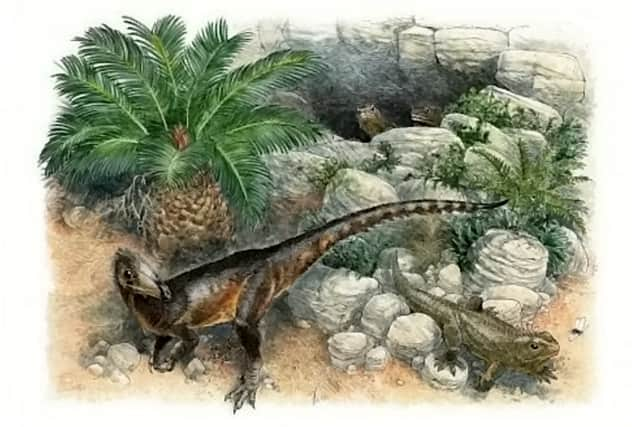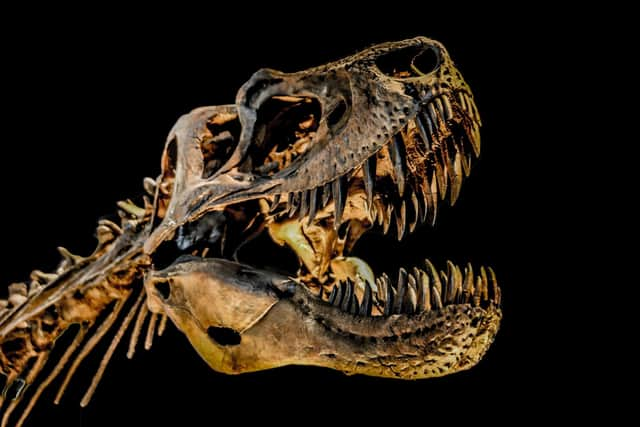Dinosaur discoveries: University of Birmingham Professor helps trace roots of Britain’s oldest meat eating dinosaur
This article contains affiliate links. We may earn a small commission on items purchased through this article, but that does not affect our editorial judgement.


This chicken sized creature is Britain’s oldest meat eating dinosaur - and it was found in Wales.
The Pendraig milnerae, whose name is Welsh for ‘Chief Dragon’, measured three foot three inches from beak to tail - and was one of the first theropods.
Advertisement
Hide AdAdvertisement
Hide AdThe carnivores went on to range from the ‘king of the dinosaurs’ - to modern birds.
Pendraig has been placed at the roots of their family tree and is related to T Rex - the deadliest animal that ever lived. Reaching up to 40 feet long and weighing eight tons, it was bigger than a bus.
It lived at the end of the Cretaceous, around 68 to 66 million years ago - until a giant space rock wiped out all non-avian dinosaurs.
Pendraig is believed to have emerged through a phenomenon known as ‘island dwarfism’.
Advertisement
Hide AdAdvertisement
Hide AdIt was identified from the fossilised remains of three individuals dug up in a quarry in Pant-y-ffynnon in the Vale of Glamorgan.
Prof Richard Butler, of Birmingham University, who has co-written a book about the discovery said: "Dinosaur discoveries are really rare in Wales, and this is only the third dinosaur species known from the country.
"It’s very exciting to learn more about the dinosaurs that lived here in the UK during the Triassic, right at the dawn of dinosaur evolution."
Co-author Dr Stephan Spiekman, of the Natural History Museum, said: "Pendraig milnerae lived near the beginning of the evolution of the meat-eating dinosaurs.
Advertisement
Hide AdAdvertisement
Hide Ad"It is clear from the bones we have that it was a meat-eater, but early in the evolution of this group these animals were quite small, in contrast to the very famous meat-eating dinosaurs like T Rex which evolved much later."


What did the excavators find?
The remains included an articulated pelvic girdle, fragments of the spine and vertebrae and thigh and hip bones.
The prehistoric graveyard has yielded a rich cache of bizarre species previously unknown to science since the early 1950s.
Dr Spiekman said: "Pendraig was among strange four limbed animals living on an archipelago.
Advertisement
Hide AdAdvertisement
Hide Ad"It has been suggested these animals were smaller than their closest relatives living on the mainland.
"It was the result of an evolutionary phenomenon called insular dwarfism. Pendraig is indeed remarkably small."
It would have fed on giant rats and other mammals.
But Wales isn’t an island?
During the Late Triassic, the area that became south Wales and south-west England was an archipelago.
The series of tiny islands were inhabited with dinosaurs, strange armoured reptiles and primitive mammals.
Advertisement
Hide AdAdvertisement
Hide AdExplained Dr Spiekman: "The area where these specimens were found was most likely an island during the time period in which it lived.
"Species which live on islands often tend to become smaller than those on the mainland in a phenomenon called island dwarfism.
"Because the fossil reptiles from this area, including Pendraig, are all quite small-sized, we used statistical analyses to investigate whether Pendraig might have been an insular dwarf.
"The results indicate Pendraig is indeed small, even for a theropod of that time period, but not uniquely so.
Advertisement
Hide AdAdvertisement
Hide Ad"Furthermore, based on several characters on the bones, we were able to determine that, although the specimens of Pendraig were not very young, they were also likely not fully grown.
"So Pendraig might have gotten somewhat bigger than the specimens we have so far, which limits our ability to perform reliable body size analyses.
"With this in mind, we need more evidence from more species to investigate the potential for island dwarfism in this area during that time, but if we could prove it, it would be the earliest known occurrence of this evolutionary phenomenon."
Pendraig milnerae also honours British dinosaur expert Dr Angela Milner who died last month.
Are there any other dinosaur remains about to be found?
Advertisement
Hide AdAdvertisement
Hide AdPendraig is described in the Royal Society journal Open Science. Last week it was reported two new killer dinosaurs - each as big as a school bus - had been found on the Isle of Wight.
A message from the editor:
Thank you for reading. BirminghamWorld is Birmingham’s latest news website, championing everything that is great about our city - reporting on news, lifestyle and sport. We want to start a community among our readers, so please follow us on Facebook,Twitter and Instagram, and keep the conversation going.
Comment Guidelines
National World encourages reader discussion on our stories. User feedback, insights and back-and-forth exchanges add a rich layer of context to reporting. Please review our Community Guidelines before commenting.